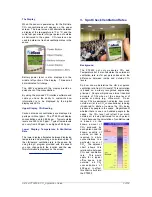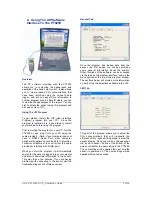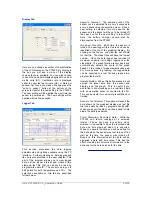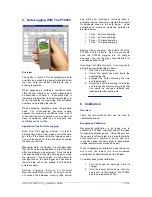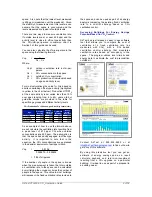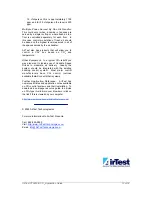
AirTest PT9250 & CO
2
Application Guide
4 of
12
When a space is under-ventilated, CO
2
levels will
be very high (e.g. over 1500 ppm). Conversely,
concentration of CO
2
close to outside levels
(typically around 400 to 450 ppm) indicates very
high ventilation, or perhaps over-ventilation.
Levels of approximately 1100 ppm will indicate a
ventilation rate of 15 cfm per person, which is
typically required by most ventilation codes.
Spot Measurement Application Tips
Note CO
2
Is Not Harmful In Building
Environments
:
It is important to note that at the
levels we normally measure in buildings CO
2
itself is not harmful. In an occupational health
environment, exposure to CO
2
levels up to 5,000
ppm over 8 hours, is considered acceptable by
OSHA. In buildings the CO
2
concentration is
more an indication of ventilation. If a space feels
uncomfortable, stuffy, or stale and the CO
2
levels
are high, it is not really the CO
2
having the effect.
The high CO
2
levels are telling you that
ventilation is insufficient, and you are likely
reacting to all the things that build up when there
is insufficient fresh air ventilation.
CO
2
Levels Must Be Stable For An Accurate
Spot Ventilation Measurement:
A true
correlation between CO
2
levels and ventilation
rate can only be made by a spot measurement
when concentrations appear to have stabilized in
a space. If levels are continuing to change it may
be an inappropriate time to measure ventilation.
For low-density office spaces and retail
applications it is best to take measurements 2-3
hours after occupancy in the space has begun
(late morning or afternoon). In higher density
applications like school classrooms, theaters and
meeting rooms measurements can be made 15
to 20 minutes after the start of occupancy.
Avoid Measurements When Building
Economizer Is On:
Be aware that ventilation
rates will appear very high if the building is
operating in economizer mode (using outside air
for free cooling). It is best to ensure the
economizer is temporarily disabled or not
operating when performing spot CO
2
measurements.
Measurement Location Tips:
Carbon dioxide
will readily disperse and equalize within a space.
Therefore measurements can be taken just about
anywhere or at any height. However one should
keep away from open doors or windows as well
as the area directly surrounding a discharge grill.
Blowing Into The Sensor:
Pure exhaled breath
contains 40,000 ppm of CO
2
that will readily
disperse in air. Try to avoid breathing directly on
the sensor when taking a measurement. If you
do breath into the sensor, it will not hurt the
sensor but it may take a few minutes for the
sensor to readjust to normal background levels.
Since the PT9250 measures up to 10,000 ppm
you may also temporarily send the display off
scale.
Estimating The Total Ventilation Rate To A
Space:
If you actually count the number of
people in the space when you take the
measurement, you can multiply this number
times the cfm-per-person ventilation rate to
determine the total amount of outside air being
delivered to the space.
Using Actual Outside CO
2
Levels To Calculate
Ventilation Rate:
In some cases you may find
that the outside levels are slightly higher or lower
than the 400 ppm level assumed by the PT9250.
(A difference of about 50 ppm will result in an
error of about 0.5 cfm/person in the calculation.)
For a more accurate calculation of ventilation
rates you can reset the outside level used in the
PT9250 calculation based on actual conditions by
exposing the sensor to outside air. Once levels
have stabilized, press the power button for about
a second. The word “read” should flash on the
screen. Now the outside concentration you just
measured will be used for the calculation of
ventilation rate until you power off the sensor.
Once powered up again the sensor will assume
an outside level of 400 ppm until you power the
unit off.
Battery Life
: Battery life of the sensor is 8 to 14
hours. It is a good idea to charge the sensor up
every night. Regular charging will not hurt the
battery inside the PT9250.
Car Charging:
If desired you can also purchase
an automotive phone charger to keep the sensor
powered up between calls. Select a charger with
a 3.5 mm (od) connector that provides an output
voltage of 6 VDC with a current of 500 mA. The
plug-in is configured for positive in the center and
negative on the outer portion of the plug. Call
AirTest for further information.
Battery Charge Indicator:
The current battery
charge level is indicated by the small graphic
symbol on the left side of the line dividing the
upper and lower display. Three bars indicate a
full charge.
Calibration:
There are a number of easy ways
to calibrate the sensor. These are discussed in
section 6 of this document.



